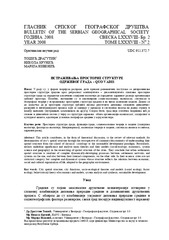Приказ основних података о документу
Sustainable city spatial structure research: Quo vadis?
Istraživanja prostorne strukture održivog grada - quo vadis?
| dc.creator | Tošić, Dragutin | |
| dc.creator | Krunić, Nikola | |
| dc.creator | Nevenić, Marija | |
| dc.date.accessioned | 2018-12-26T10:55:13Z | |
| dc.date.available | 2018-12-26T10:55:13Z | |
| dc.date.issued | 2008 | |
| dc.identifier.issn | 0350-3593 | |
| dc.identifier.uri | https://raumplan.iaus.ac.rs/handle/123456789/141 | |
| dc.description.abstract | This article contributes, in the form of theoretical discussion, to the review of relevant methods for determination of city's spatial structure through the retrospective of continuity/discontinuity of understanding their spatial structure from the school of classical sociology to the sustainable development paradigm. Particularly, authors underline significance and analyze main theories and their models (social-ecology, economics, system science and geography) in the researching of spatial structure of the cities. They conclude that urban settlements spatial structure is resultant of complex dynamically-developing processes between settlements networks and systems on the one, and also between their internal components, on the other side. In their essence, cities are not statistical category, but complex and dynamical system whose structure reflects the relations between economic, social and cultural organization of life, adapted to the geographic environment. | en |
| dc.description.abstract | U radu su, u formi teorijske rasprave, dati prikazi relevantnih postupaka za determinisnje prostorne strukture gradova kroz retrospekt kontinuiteta - diskontinuiteta shvatanja prostorne strukture grada od paradigme klasične socijalne ekologije do paradigme održivog razvoja organizacije urbanog prostora. Posebno, naglašene su i analizirane socio-ekološke, ekonomske, sistemske i geografske teorije u istraživanju prostornih struktura gradova i na njima zasnovani modeli. Došlo se do zaključka da je prostorna struktura urbanih naselja rezultanta delovanja složenih dinamično- razvojnih i integracijskih procesa koji se odvijaju u mrežama i sistemima naselja na jednoj strani, i između njihovih unutrašnjih komponenata na drugoj. Svojom biti, grad nije statična tvorevina već je složen i dinamičan sistem u čijoj se strukturi odražava oblik organizacije ekonomskog, socijalnog i kulturnog života, adaptiran uslovima geografske sredine u kojoj egzistira. | sr |
| dc.publisher | Serbian Geographical Society | |
| dc.relation | info:eu-repo/grantAgreement/MESTD/MPN2006-2010/146010/RS// | |
| dc.rights | openAccess | |
| dc.rights.uri | https://creativecommons.org/licenses/by-nc-nd/4.0/ | |
| dc.source | Glasnik Srpskog geografskog društva | |
| dc.subject | city spatial structure | en |
| dc.subject | city functions | en |
| dc.subject | socio-ecological theories and models (social ecology, factor ecology, behaviorism) | en |
| dc.subject | theory of economics and models | en |
| dc.subject | system analysis and synthesis | en |
| dc.subject | sustainable development | en |
| dc.subject | prostorna struktura grada | sr |
| dc.subject | funkcije grada | sr |
| dc.subject | socioekološke teorije i modeli (socijalnaekologija, faktorska ekologija, bihejviorizam) | sr |
| dc.subject | ekonomske teorije i modeli | sr |
| dc.subject | sistemska analiza i sinteza | sr |
| dc.subject | održivi razvoj | sr |
| dc.title | Sustainable city spatial structure research: Quo vadis? | en |
| dc.title | Istraživanja prostorne strukture održivog grada - quo vadis? | sr |
| dc.type | article | |
| dc.rights.license | BY-NC-ND | |
| dcterms.abstract | Тошић, Драгутин; Невенић, Марија; Крунић, Никола; | |
| dc.citation.volume | 88 | |
| dc.citation.issue | 2 | |
| dc.citation.spage | 36 | |
| dc.citation.epage | 44 | |
| dc.citation.other | 88(2): 36-44 | |
| dc.identifier.doi | 10.2298/GSGD0802036T | |
| dc.identifier.fulltext | https://raumplan.iaus.ac.rs//bitstream/id/1490/138.pdf | |
| dc.type.version | publishedVersion |

